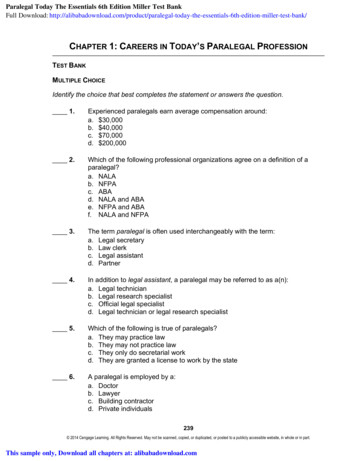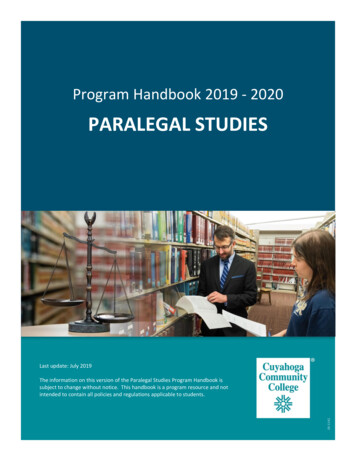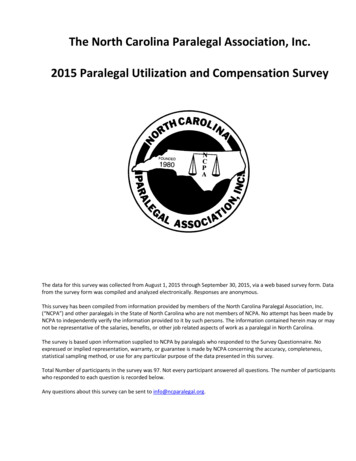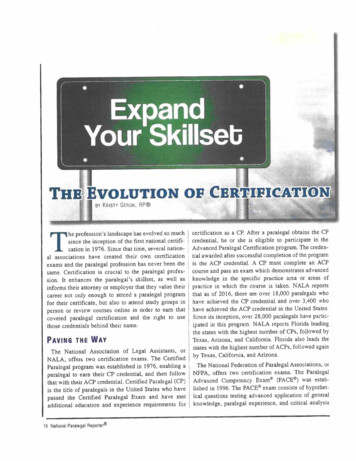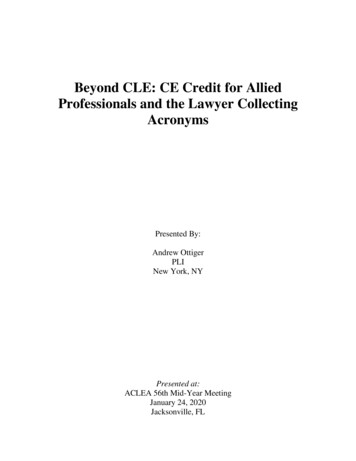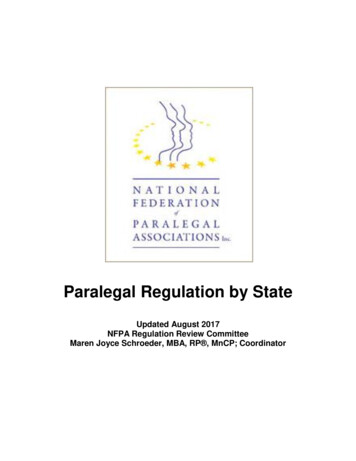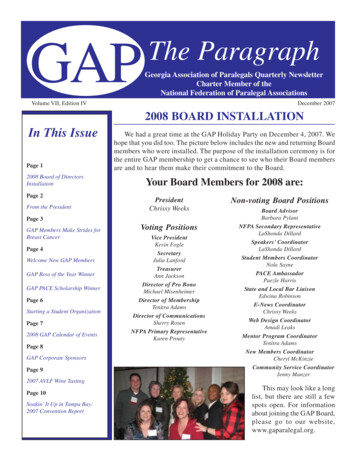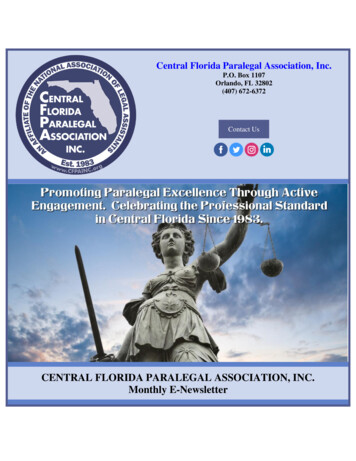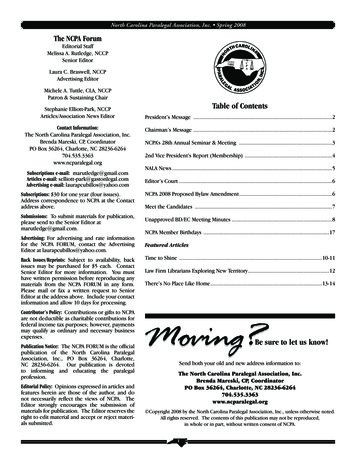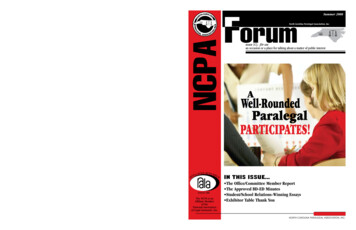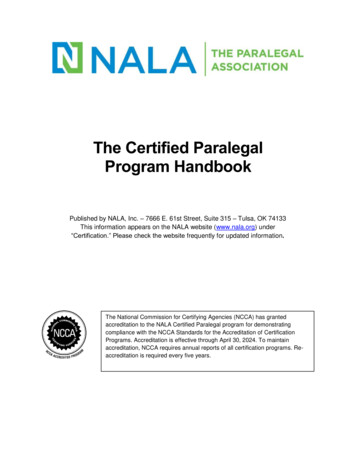
Transcription
The Certified ParalegalProgram HandbookPublished by NALA, Inc. – 7666 E. 61st Street, Suite 315 – Tulsa, OK 74133This information appears on the NALA website (www.nala.org) under“Certification.” Please check the website frequently for updated information.The National Commission for Certifying Agencies (NCCA) has grantedaccreditation to the NALA Certified Paralegal program for demonstratingcompliance with the NCCA Standards for the Accreditation of CertificationPrograms. Accreditation is effective through April 30, 2024. To maintainaccreditation, NCCA requires annual reports of all certification programs. Reaccreditation is required every five years.
Table of ContentsCertification . 1Description of Program . 1Purpose of the Certified Paralegal Certification Program . 1Administration. 1Accreditation of Certified Paralegal Program . 2Background and Numbers . 2The Certified Paralegal Credential . 2Is it Legal Assistant or Paralegal? . 2Am I a Certified Paralegal? . 3The Certified Paralegal Exam Description . 4How the Certified Paralegal Exam is Developed . 4Exam Specifications . 4Examination Format . 5Examination Points and Passing Scores . 6Passing Score for Each Section of the Certified Paralegal Examination . 72016 Job Analysis Report . 7Examinee Application and Policies . 8Steps - Application Procedure and Testing Appointments . 8Ineligibility .10Documentation Required to Complete the Application Form .10Examinee Attestation .11Fees .12Withdrawal, Incomplete, or Rejected Applications .12Testing Center Fees .12General Policies .12Appeal Process for Applicants who Receive an Adverse Eligibility Decision .14Cheating and Misconduct in the Certified Paralegal Examination Program .15Examination Results .16NALA Code of Ethics and Professional Responsibility .17Testing Centers and Policies Options of Testing Centers .19PSI Testing Center Network .19PSI Testing Center Network and Appointments .20Testing Center Locations .21Testing Center Rules – All Centers Terms and Conditions of Testing .23Terms and Conditions .23Presentation of Computer-Based Exam Questions .27Recertification Process Policies and Procedures for Certified Paralegals .29Limitations to the Definition of Continuing Competence .29Ethical Standards .29Types of CLE Programs and Calculation of Hours .30Reporting Hours in the Area of Legal Ethics .33Filing Procedures for All Types of CLE .33Recertification Affidavit and Fee .33Pre-Approval .34Retired Status of Certified Paralegals .34Procedure for Notice of Revocation of Certified Paralegal Credential for Failure to Meet CLERequirements .35i
Appeal of Revocation of Certified Paralegal Credential for Failure to Meet CLE Requirements.35Hardship or Extreme Circumstances as Basis of Appeal .35Use of Certification Mark .36Appendix A - Request for Accommodation.38Appendix B - Certified Paralegal Examination Screen Shots .40Appendix C – Certificate of Attendance .50Appendix D - Recertification Affidavit .53Appendix E – Request for Certified Paralegal Retired Status .52Appendix F – Request for Certified Paralegal Status – Permanent Disability .53Appendix G – Certified Paralegal Reactivation Affidavit .54Appendix H – Appeal Form .55ii
CertificationDescription of ProgramIn the working environment, professional certification is a time-honored process respected byboth employers and those within the career field. The following is a definition used by many todescribe professional certification: “Professional certification is a voluntary process by which anongovernmental entity grants a time-limited recognition to an individual after verifying that theindividual has met predetermined, standardized criteria” (Rops, M., Understanding theLanguage of Credentialing, American Society of Association Executives, May 2002).The definition hits the high points. Certification is voluntary, not imposed by government. It istime limited, which means that those with the certification must fulfill ongoing educationalrequirements to keep the certification current, and the criteria for certification is recognized inthe community.Purpose of the Certified Paralegal Certification ProgramEstablished in 1976, NALA's Certified Legal Assistant ("CLA") program allowed the paralegalprofession to develop a strong and responsive self-regulatory program offering a nationwidecredential for paralegals. The Certified Paralegal program establishes and serves as a: National professional standard for paralegals.Means of identifying those who have reached this standard.Credentialing program responsive to paralegal needs and responsive to the necessity ofself-regulation to strengthen and expand paralegal career development.Positive, ongoing voluntary program to encourage the growth of the paralegalprofession, attesting to and encouraging a high level of achievement.The Certified Paralegal credential has been developed to recognize paralegals who havedemonstrated entry-level knowledge and skill to provide competent assistance in the delivery oflegal services for lawyers, law offices, corporations, or governmental agencies in the UnitedStates. The CP credential is a prestigious indicator to clients, potential clients, employers, andthe public at large that the paralegal professional has proficiency in the legal services field.When the CLA program was developed, the preferred term was “legal assistant” to designate anon-lawyer employee with specialized education who does work of a legal nature that, absentthe legal assistant, the attorney would perform. Legal assistant time is billed to clients at marketrates in the same manner as other legal professional staff. By 2004, the preferred term changedto “paralegal” even though bar association rules and guidelines, and some statutes still used theterm “legal assistant.” In 2004 NALA registered the certification mark CP and in 2019encouraged paralegals to use the CP . Since 2011, the term “paralegal” is used almostexclusively, and the certification program is referred to as the Certified Paralegal program whichawards the Certified Paralegal credential.AdministrationThe NALA Certifying Board is responsible for content, standards and administration of theCertified Paralegal Program. It is composed of paralegals who have received the CertifiedParalegal certification designation, attorneys, and paralegal educators.1
Accreditation of Certified Paralegal ProgramThe National Commission for Certifying Agencies (NCCA) has grantedaccreditation to the NALA Certified Paralegal program since 2014 fordemonstrating compliance with the NCCA Standards for the Accreditation ofCertification Programs. NCCA is the accrediting body of the Institute forCredentialing Excellence. The NCCA Standards were created to ensurecertification programs adhere to modern standards of practice for thecertification industry. The NALA Certified Paralegal program joins an elitegroup of more than 120 organizations representing over 270 certificationprograms that have received and maintained NCCA accreditation. More information on theNCCA is available online at www.credentialingexcellence.org/NCCA. To maintain accreditation,NCCA requires annual reports of all certification programs. Re-accreditation is required everyfive years.Background and NumbersEstablished in 1976, the CLA (Certified Legal Assistant) program has enabled the profession todevelop a strong and responsive self-regulatory program offering a nationwide credential forlegal assistants. The Certified Paralegal program establishes and serves as a: National professional standard for legal assistantsMeans of identifying those who have reached this standard.Credentialing program responsive to the needs of paralegals/legal assistants andresponsive to the fact that this form of self-regulation is necessary to strengthen andexpand development of this career field.Positive, ongoing, voluntary program to encourage the growth of the paralegal/legalassistant profession, attesting to and encouraging a high level of achievement.There are more than 19,000 (active and inactive) Certified Paralegals and more than 4,000Advanced Certified Paralegals in the United States. More than 33,000 paralegals haveparticipated in this program. A table of the numbers of Certified Paralegals is included at the endof this document.The Certified Paralegal CredentialUse of the Certified Paralegal credential signifies that a paralegal is capable of providingsuperior services to firms and corporations. National surveys consistently show CertifiedParalegals are better utilized in a field where attorneys are looking for a credible, dependableway to measure ability. The credential has been recognized by the American Bar Association asa designation which marks a high level of professional achievement. The CP credential has alsobeen recognized by more than 47 paralegal organizations and numerous bar associations.Is it Legal Assistant or Paralegal?The terms "legal assistant" and "paralegal" are synonymous terms. The terms are defined assuch throughout the United States in state supreme court rules, statutes, ethical opinions, barassociation guidelines and other similar documents. These are the same documents whichprovide recognition of the paralegal profession and encourage the use of paralegals in thedelivery of legal services.i
NALA has become increasingly aware that while the terms are the same as "lawyer" and"attorney", a preference in terms is emerging. Different geographic areas use one term morethan another. For this reason, NALA filed for a certification mark "CP" with the US Patent andTrademark Office. The certification mark was successfully registered on July 20, 2004.Am I a Certified Paralegal?Occasionally, paralegals call themselves "certified" by virtue of completing a paralegal trainingcourse, or another type of preparatory education. Although a school may award a certificate ofcompletion, this is not the same as earning professional certification by an entity such as NALA.In this instance the school's certificate is designation of completion of a training program.3
The Certified Paralegal Exam DescriptionHow the Certified Paralegal Exam is DevelopedThe Certifying Board provides oversight for the development and ongoing maintenance of theexamination. The Certifying Board, NALA certification program staff, and trained subject matterexperts, work in partnership with a qualified psychometric consultant to ensure the examinationis developed and maintained in a manner consistent with generally accepted psychometric,educational testing practices, and national accreditation standards for certification programs.The Certifying Board selects diverse groups of qualified subject matter experts (SMEs) toparticipate in exam development activities throughout the exam development and maintenanceprocess. Activities that involve subject matter expert participation include creating job analysissurveys, creating test content outlines, writing and reviewing exam items, and establishing thepassing point for exams. Ad- hoc committees and/or working groups of subject matter expertscomposed of Certifying Board members, paralegals, attorneys, educators, and other outsideexperts may be assembled for these tasks.Job analysis studies are conducted periodically to identify and validate the knowledge and skillswhich will be measured by the examination sections. The results of the job analysis studiesserve as the basis for the exam specifications. These exam specifications, with weights for eachcontent area, are approved by the Certifying Board.Qualified subject matter experts write and review items for the exam. Subject matter expert itemwriters and reviewers complete mandatory training on item writing/review for certificationexaminations. Items are subject to multiple levels of review and analysis before being used asgraded items on the exam.The Certifying Board oversees a continual process of item writing, review and evaluation toensure that exam content remains up-to-date, accurate, and consistent with the content outline.All NALA certification examinations are prepared and offered in English only. Specialaccommodations such as requesting translation dictionaries are not permitted; no languageassistance will be authorized by the Certifying Board.Exam SpecificationsIn October 2016, the NALA Certifying Board conducted its 2016 Job Task Analysis Study("Study"). This Study examined the duties and responsibilities of paralegals in the workplace andthe goals were to: Validate and update the Certified Paralegal examination content; andEnsure that NALA has current information about the roles and responsibilities ofparalegals.Based on analysis of the Study, improvements in technology, and recent refinements by theNational Commission for Certifying Agencies (NCCA), and the advice of NALA’spsychometricians, the Certifying Board approved a new structure for the Certified Paralegalexamination effective January 2018.NALA also modified some policies and procedures based upon best practices in credentialingprograms, and they are posted on its website under the Certification link and included in thisHandbook.i
The new examination format opened in March 2018 for one-month of post-administrationanalysis, scoring, and standard setting.With these modifications, the Certifying Board listened to member and nonmember paralegalsworking in the field, and applied findings of the Study to the examination. The Certifying Boardworks diligently to connect the Certified Paralegal examination directly to the day-to-day dutiesand responsibilities of paralegals in the workplace. The modifications announced for the 2018examination are part of the continued effort to ensure the Certified Paralegal examinationremains an accurate and relevant reflection of today’s paralegals.Examination FormatThe Certified Paralegal examination consists of two required sections taken in the following order:Knowledge Exam and then the Skills Exam.Knowledge examThe Knowledge Exam consists of multiple-choice questions covering the topic areas listed in thetable below. The Knowledge Exam is administered on-demand, year-round at testing centers orwith an approved exam proctor, with preliminary result reporting upon completion. Candidatesmust successfully complete the Knowledge Exam in order to be eligible to take the Skills Exam.Skills examThe Skills Exam will consist of a written assignment; specifications are listed below. The SkillsExam is administered during four testing windows each year: February, April, July, and October.Successful completion of both the Knowledge and Skills Exams is required to obtain the CertifiedParalegal credential.Certified Paralegal Exam Specifications – Effective 2018Knowledge Exam11.AUnited States Legal SystemSources of Law1.B1.C1.D2Judicial SystemRemediesAdministrative Law2.A2.B33.A3.B44.A4.B4.C5Civil LitigationJurisdictionFederal Rules of Civil ProcedureContractsFormation, Rights, and DutiesEnforcement and DefensesCorporate/Commercial LawBusiness OrganizationsRights andResponsibilitiesTransactionsCriminalLaw and Procedure100 points1515151055
Knowledge Exam100 points5.A5.B66.A6.B77.A7.B8Criminal LawCriminal ProcedureEstate Planning and ProbateEstate and TrustsWillsReal Estate and PropertyProperty Rights and CNegligence9Professional and Ethical Responsibility9.AAmerican Bar Association (ABA) Model R
The Certified Paralegal Program Handbook Published by NALA, Inc. – 7666 E. 61st Street, Suite 315 – Tulsa, OK 74133 This information appears on the NALA website (www.nala.org) under “Certification.” Ple
